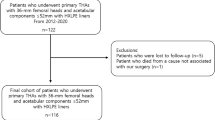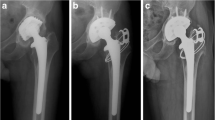Abstract
Purpose
Due to the high number of total hip arthroplasties (THA) revised due to instability, the use of large femoral heads to reduce instability is justifiable. It is critical to determine whether or not large femoral heads used in conjunction with thin polyethylene liners lead to increased wear rates, which can lead to osteolysis. Therefore, by using validated wear-analysis software, we evaluated linear wear rates in a consecutive cohort of patients who underwent primary THA with thin polyethylene liners.
Methods
All patients were selected from a consecutive, prospectively collected database of 241 THAs performed at a single institution by two fellowship-trained joint-reconstruction surgeons between July 2007 and June 2011. These patients were 1:1 matched to a cohort of patients who had conventional-thickness polyethylene liners.
Results
No significant differences were observed between linear wear rates of thin or conventional-thickness liners. The Kaplan–Meier survivorship for both cohorts was 100 %, and no cases of polyethylene fracture were observed in either cohort.
Conclusions
Our results suggest that according to a mean follow-up of 4 years, the use of thin liners in THA is promising. Longer follow-up is required to assess whether these outcomes are observed later.

Similar content being viewed by others
References
Kurtz S, Ong K, Lau E, Mowat F, Halpern M (2007) Projections of primary and revision hip and knee arthroplasty in the United States from 2005 to 2030. J Bone Joint Surg Am 89:780–785. doi:10.2106/JBJS.F.00222
Bozic KJ, Kurtz SM, Lau E, Ong K, Vail TP, Berry DJ (2009) The epidemiology of revision total hip arthroplasty in the United States. J Bone Joint Surg Am 91:128–133. doi:10.2106/JBJS.H.00155
Lachiewicz PF, Heckman DS, Soileau ES, Mangla J, Martell JM (2009) Femoral head size and wear of highly cross-linked polyethylene at 5 to 8 years. Clin Orthop Relat Res 467:3290–3296. doi:10.1007/s11999-009-1038-9
Howie DW, Holubowycz OT, Middleton R, Large Articulation Study G (2012) Large femoral heads decrease the incidence of dislocation after total hip arthroplasty: a randomized controlled trial. J Bone Joint Surg Am 94:1095–1102. doi:10.2106/JBJS.K.00570
Garbuz DS, Masri BA, Duncan CP, Greidanus NV, Bohm ER, Petrak MJ, Della Valle CJ, Gross AE (2012) The Frank Stinchfield Award: Dislocation in revision THA: do large heads (36 and 40 mm) result in reduced dislocation rates in a randomized clinical trial? Clin Orthop Relat Res 470:351–356. doi:10.1007/s11999-011-2146-x
Cooper HJ, Della Valle CJ (2014) Large diameter femoral heads: is bigger always better? Bone Joint J 96-B:23–26. doi:10.1302/0301-620X.96B11.34342
Falez F, La Cava F, Panegrossi G (2000) Femoral prosthetic heads and their significance in polyethylene wear. Int Orthop 24:126–129
Sayeed SA, Mont MA, Costa CR, Johnson AJ, Naziri Q, Bonutti PM, Delanois RE (2011) Early outcomes of sequentially cross-linked thin polyethylene liners with large diameter femoral heads in total hip arthroplasty. Bull NYU Hosp Jt Dis 69(Suppl 1):S90–S94
Ingham E, Fisher J (2000) Biological reactions to wear debris in total joint replacement. Proc Inst Mech Eng H 214:21–37
Rajadhyaksha AD, Brotea C, Cheung Y, Kuhn C, Ramakrishnan R, Zelicof SB (2009) Five-year comparative study of highly cross-linked (crossfire) and traditional polyethylene. J Arthroplast 24:161–167. doi:10.1016/j.arth.2007.09.015
D’Antonio JA, Manley MT, Capello WN, Bierbaum BE, Ramakrishnan R, Naughton M, Sutton K (2005) Five-year experience with Crossfire highly cross-linked polyethylene. Clin Orthop Relat Res 441:143–150
Martell JM, Verner JJ, Incavo SJ (2003) Clinical performance of a highly cross-linked polyethylene at two years in total hip arthroplasty: a randomized prospective trial. J Arthroplast 18:55–59
Bitsch RG, Loidolt T, Heisel C, Ball S, Schmalzried TP (2008) Reduction of osteolysis with use of Marathon cross-linked polyethylene. A concise follow-up, at a minimum of five years, of a previous report. J Bone Joint Surg Am 90:1487–1491. doi:10.2106/JBJS.F.00991
Digas G, Karrholm J, Thanner J, Herberts P (2007) 5-year experience of highly cross-linked polyethylene in cemented and uncemented sockets: two randomized studies using radiostereometric analysis. Acta Orthop 78:746–754. doi:10.1080/17453670710014518
Snir N, Kaye ID, Klifto CS, Hamula MJ, Wolfson TS, Schwarzkopf R, Jaffe FF (2014) 10-year follow-up wear analysis of first-generation highly cross-linked polyethylene in primary total hip arthroplasty. J Arthroplast 29:630–633. doi:10.1016/j.arth.2013.07.034
Tower SS, Currier JH, Currier BH, Lyford KA, Van Citters DW, Mayor MB (2007) Rim cracking of the cross-linked longevity polyethylene acetabular liner after total hip arthroplasty. J Bone Joint SurgAm 89:2212–2217. doi:10.2106/JBJS.F.00758
Pijls BG, der Linden-Van V, der Zwaag HM, Nelissen RG (2012) Polyethylene thickness is a risk factor for wear necessitating insert exchange. Int Orthop 36:1175–1180. doi:10.1007/s00264-011-1412-6
Ranawat AS, Tsailis P, Meftah M, Koob TW, Rodriguez JA, Ranawat CS (2012) Minimum 5-year wear analysis of first-generation highly cross-linked polyethylene in patients 65 years and younger. J Arthroplast 27:354–357. doi:10.1016/j.arth.2011.07.003
Geerdink CH, Grimm B, Vencken W, Heyligers IC, Tonino AJ (2008) The determination of linear and angular penetration of the femoral head into the acetabular component as an assessment of wear in total hip replacement: a comparison of four computer-assisted methods. J Bone Joint Surg Br 90:839–846. doi:10.1302/0301-620X.90B7.20305
Hui AJ, McCalden RW, Martell JM, MacDonald SJ, Bourne RB, Rorabeck CH (2003) Validation of two and three-dimensional radiographic techniques for measuring polyethylene wear after total hip arthroplasty. J Bone Joint Surg Am 85-A:505–511
Zahiri CA, Schmalzried TP, Szuszczewicz ES, Amstutz HC (1998) Assessing activity in joint replacement patients. J Arthroplast 13:890–895
Dowd JE, Sychterz CJ, Young AM, Engh CA (2000) Characterization of long-term femoral-head-penetration rates. Association with and prediction of osteolysis. J Bone Joint Surg Am 82-A:1102–1107
Chua W, Roy S, Sng J, Liang S, de Das S (2014) Total hip replacement using a highly cross-linked polyethylene liner in Asians with small acetabulum. J Orthop Surg (Hong Kong) 22:342–346
Plank GR, Estok DM 2nd, Muratoglu OK, O’Connor DO, Burroughs BR, Harris WH (2007) Contact stress assessment of conventional and highly cross-linked ultra high molecular weight polyethylene acetabular liners with finite element analysis and pressure sensitive film. J Biomed Mater Res B Appl Biomater 80:1–10. doi:10.1002/jbm.b.30560
Oonishi H, Iwaki H, Kin N, Kushitani S, Murata N, Wakitani S, Imoto K (1998) The effects of polyethylene cup thickness on wear of total hip prostheses. J Mater Sci Mater Med 9:475–478
Heisel C, Silva M, dela Rosa MA, Schmalzried TP (2004) Short-term in vivo wear of cross-linked polyethylene. J Bone Joint Surg Am 86-A:748–751
D’Antonio JA, Capello WN, Ramakrishnan R (2012) Second-generation annealed highly cross-linked polyethylene exhibits low wear. Clin Orthop Relat Res 470:1696–1704. doi:10.1007/s11999-011-2177-3
Olyslaegers C, Defoort K, Simon JP, Vandenberghe L (2008) Wear in conventional and highly cross-linked polyethylene cups: a 5-year follow-up study. J Arthroplast 23:489–494. doi:10.1016/j.arth.2007.02.013
Campbell DG, Field JR, Callary SA (2010) Second-generation highly cross-linked X3 polyethylene wear: a preliminary radiostereometric analysis study. Clin Orthop Relat Res 468:2704–2709. doi:10.1007/s11999-010-1259-y
Orishimo KF, Claus AM, Sychterz CJ, Engh CA (2003) Relationship between polyethylene wear and osteolysis in hips with a second-generation porous-coated cementless cup after seven years of follow-up. J Bone Joint Surg Am 85-A:1095–1099
Lee JH, Lee BW, Lee BJ, Kim SY (2011) Midterm results of primary total hip arthroplasty using highly cross-linked polyethylene: minimum 7-year follow-up study. J Arthroplast 26:1014–1019. doi:10.1016/j.arth.2011.03.015
Fukui K, Kaneuji A, Sugimori T, Ichiseki T, Kitamura K, Matsumoto T (2011) Wear comparison between a highly cross-linked polyethylene and conventional polyethylene against a zirconia femoral head: minimum 5-year follow-up. J Arthroplast 26:45–49. doi:10.1016/j.arth.2009.11.005
Miyanishi K, Hara T, Kaminomachi S, Maekawa M, Iwamoto M, Torisu T (2008) Short-term wear of Japanese highly cross-linked polyethylene in cementless THA. Arch Orthop Trauma Surg 128:995–1000. doi:10.1007/s00402-007-0544-z
Mutimer J, Devane PA, Adams K, Horne JG (2010) Highly cross-linked polyethylene reduces wear in total hip arthroplasty at 5 years. Clin Orthop Relat Res 468:3228–3233. doi:10.1007/s11999-010-1379-4
Thomas GE, Simpson DJ, Mehmood S, Taylor A, McLardy-Smith P, Gill HS, Murray DW, Glyn-Jones S (2011) The seven-year wear of highly cross-linked polyethylene in total hip arthroplasty: a double-blind, randomized controlled trial using radiostereometric analysis. J Bone Joint Surg Am 93:716–722. doi:10.2106/JBJS.J.00287
Reynolds SE, Malkani AL, Ramakrishnan R, Yakkanti MR (2012) Wear analysis of first-generation highly cross-linked polyethylene in primary total hip arthroplasty: an average 9-year follow-up. J Arthroplast 27:1064–1068. doi:10.1016/j.arth.2012.01.006
Vendittoli PA, Riviere C, Lavigne M, Lavoie P, Alghamdi A, Duval N (2013) Alumina on alumina vs metal on conventional polyethylene: a randomized clinical trial with 9 to 15 years follow-up. Acta Orthop Belg 79:181–190
Borlin N, Rohrl SM, Bragdon CR (2006) RSA wear measurements with or without markers in total hip arthroplasty. J Biomech 39:1641–1650. doi:10.1016/j.jbiomech.2005.05.004
Maguire GQ Jr, Noz ME, Olivecrona H, Zeleznik MP, Weidenhielm L (2014) A new automated way to measure polyethylene wear in THA using a high resolution CT scanner: method and analysis. Sci World J 2014:528407. doi:10.1155/2014/528407
Author information
Authors and Affiliations
Corresponding author
Rights and permissions
About this article
Cite this article
Jauregui, J.J., Naziri, Q., Pierce, T.P. et al. Is the use of thin, highly cross-linked polyethylene liners safe in total hip arthroplasty?. International Orthopaedics (SICOT) 40, 681–686 (2016). https://doi.org/10.1007/s00264-015-2841-4
Received:
Accepted:
Published:
Issue Date:
DOI: https://doi.org/10.1007/s00264-015-2841-4




